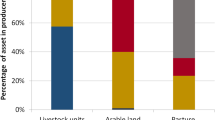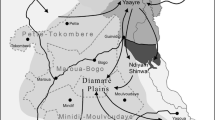Abstract
Datoga herding follows a cyclical pattern depending on the availability of grazing and water. This analysis focuses on two questions: (a) Is the herding strategy followed by individual households limited by the amount of labor available to that household? and (b) does the herding strategy followed by individual households influence the dynamics of cattle herds? The results show that the availability of labor on a household level does not influence either the herding strategies used by individual households, or the dynamics of cattle herds. This suggests that once minimum labor requirements are met, livestock productivity is insensitive to additional labor inputs.
Similar content being viewed by others
REFERENCES
Arhem, K., Homewood, K., and Rodgers, W. A. (1981). A Pastoral Food System: The Ngorongoro Maasai in Tanzania. BRALUP Research Paper, No. 70, University of Dar Es Salaam.
Borgerhoff Mulder, M. (1991). Datoga pastoralists of Tanzania. National Geographic Research and Exploration 7(2): 166–187.
Borgerhoff Mulder, M. (1992). Demography of pastoralists: Preliminary data on the Datoga of Tanzania. Human Ecology 20(4): 383–405.
Borgerhoff Mulder, M., and Sellen, D. (1994). Pastoralist decision making: A behavioral ecological perspective. In Fratkin, E., Galvin, K. A., and Roth, E. A. (eds.), African Pastoralist Systems: An Integrated Approach. Boulder, London, pp. 205–230.
Coppock, D., Ellis, J., and Swift, D. (1986). Livestock feeding ecology and resource utilisation in a nomadic pastoral ecosystem. Journal of Applied Ecology 23: 573–583.
Coppock, D. L., Ellis, J. E., and Swift, D. M. (1988). Seasonal patterns of activity, travel and water intake for livestock in South Turkana, Kenya. Journal of Arid Environments 14: 319–331.
Cossins, N. J., and Upton, M. (1988). The impact of climatic variation of the Borana pastoral system. Agricultural Systems 27: 117–278.
Dahl, G., and Hjort, A. (1976). Having herds: Pastoral growth and household economy. Department of Social Anthropology, University of Stockholm.
Fosbrooke, H. (1948). An administrative survey of the Maasai social system. Tanganyika Notes and Records 26: 1–51.
Fratkin, E. (1987). Age-sets, households and the organisation of pastoral production: The Ariaal, Samburu and Rendille of Northern Kenya. Research in Economic Anthropology 8: 295–314.
Fratkin, E. (1989). Household variation and gender inequality in Ariaal pastoral production. American Anthropologist 9(2): 430–440.
Fratkin, E., and Smith, K. (1994). Labor, livestock and land: The organization of pastoral production. In Fratkin, E., Galvin, K. A., and Roth, E. A. (eds.), African Pastoralist Systems: New Frontiers in Method and Theory. Lynne Reiner, Boulder, Colorado.
Grandin, B. (1989). Labor sufficiency, livestock management, and time allocation on Maasai group ranches. Research in Economic Anthropology 11.
Grandin, B. E., Bekure, S., and Nestel, P. (1991). Livestock transactions, food consumption and household budgets. In Bekure, S., de Leeuw, P. N., Grandin, B. E., and Neate, P. J. H. (eds.), Maasai Herding: An Analysis of the Livestock Production System of Maasai Pastoralists in Eastern Kajiado District, Kenya. Addis Ababa, Ethiopia: International Livestock Centre for Africa, pp. 103–114.
Hawkes, K., O'Connell, J. F., and Blurton Jones, N. G. (1989). Hardworking Hadza grandmothers. In Standen, V., and Foley, R. A. (eds.), Comparative Socioecology; The Behavioural Ecology of Humans and Other Mammals. Blackwell Scientific Publications, Oxford, pp. 31–366.
Homewood, K., and Hurst, A. (1986). Comparative ecology of pastoral livestock in Baringo, Kenya. Pastoral Development Network 21(b): 1–41.
Homewood, K. M., and Rodgers, W. A. (1991). Masaailand Ecology: Pastoralist Development and Wildlife Conservation in Ngorongoro, Tanzania. Cambridge University Press, Cambridge.
Kjaerby, K. (1979). The Development of Agro-Pastoralism Among the Barabaig in Hanang District. University of Dar Es Salaam, Tanzania.
Kjaerby, F. (1980). The Problem of Livestock Development and Villagization Among the Barabaig in Hanang District. BRALUP Research report No. 40 (N. S.), University of Dar Es Salaam.
Ndagala, D. K. (1991). The unmaking of the Datoga: Decreasing resources and increasing conflict in rural Tanzania. Nomadic Peoples 28: 71–82.
Scoones, I. (1992). Coping with drought: Responses of herders and livestock in contrasting savanna environments in southern Zimbabwe. Human Ecology 20(3): 293–314.
Sellen, D. (1995) The Socio-Ecology of Child Growth Among Datoga Pastoralists. PhD thesis, University of California at Davis.
Shell-Duncan, B. K. (1994). Child fostering among nomadic Turkana pastoralists: Demographic and health consequences. In Fratkin, E., Galvin, K., and Roth, E. A. (eds.), African Pastoralist Systems: An Integrated Approach. Boulder, London.
Sieff, D. F. (1995). The Effects of Resource Availability on the Subsistence Strategies of Datoga Pastoralists of North West Tanzania. PhD thesis, Institute of Biological Anthropology, University of Oxford.
Sieff, D. F. (n.d.). The effects of wealth on livestock dynamics among the Datoga pastoralists of north West Tanzania (submitted to IIED Drylands).
Sieff, D. F. Women's Work Patterns in the Datoga pastoralists of Tanzania (unpublished manuscript).
Sperling, L. (1987). The Labor Organization of Samburu Pastoralism. PhD, McGill University, Anthropology Department.
Sperling, L., and Galaty, J. G. (1990). Cattle, culture and economy: Dynamics in East African pastoralism. In Galaty, J. G., and Johnston, D. L. (eds.), The World of Pastoralism: Herding Systems in Comparative Perspective. Belhaven Press, London, pp. 69–98.
Toulmin, C. (1994). Tracking through drought: Options for destocking and restocking. In Scoones, I. (eds.), Living with Uncertainty: New Directions in Pastoral Development in Africa. Intermediate Technology Publications Ltd., London, pp. 95–115.
Author information
Authors and Affiliations
Rights and permissions
About this article
Cite this article
Sieff, D.F. Herding Strategies of the Datoga Pastoralists of Tanzania: Is Household Labor a Limiting Factor. Human Ecology 25, 519–544 (1997). https://doi.org/10.1023/A:1021829806765
Issue Date:
DOI: https://doi.org/10.1023/A:1021829806765




